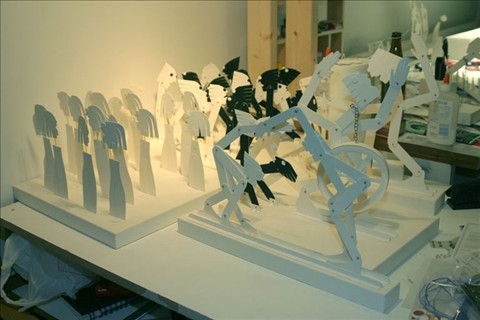I've been privileged -- blessed, really -- to know some amazing, brilliant people. Most of them seem to be musicians, which is kind of funny because I have exactly zero musical ability myself. But they fall into all kinds of categories: Writers, chefs, singers, painters, sculptors, movie producers, engineers. People who not only have a talent, but worked hard to develop it. As my old music director Professor William F. Ondrick liked to say, "There's no substitute for the work, not even genius."
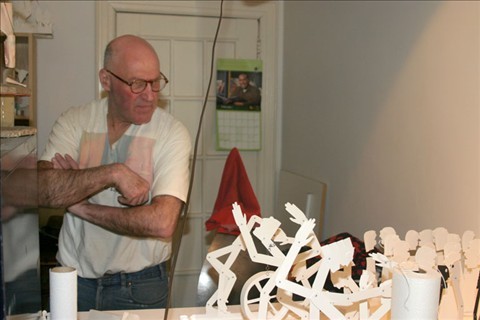
Danny certainly is one of the most remarkable people in this remarkable group of people I've been lucky enough to know. He is one of the best, most talented, most incredible people I've ever met. And I don't even know his last name. (You might have seen him around making comments under the name Danonymous.)
Danny is the most relentlessly positive, childlike adult I can imagine. He's so intent on always looking on the bright side it's almost aggressive. I know he's had a difficult time, personally, recently; I won't get into it because I don't want to make the private public, but I can say if I'd gone through what he has, this blog and all of my e-mail correspondence would be filled with nothing but whiny, puling self-pity. Hell, this blog and my e-mail are filled with that anyway and I haven't had half the troubles Dan has. And yet the closest I've heard him come to complaining is one sentence: "Well, it's been a rough year."
He also has a surprising capacity for leaving me wanting more. Today I can get on the Web and find more information than I ever wanted on almost any subject. If an artist interests me, I can often find a vast landslide of images of their work along with analysis, reviews, and complaints that they make too much or not enough money. In the midst of this information overload, Danny has somehow managed to keep a low profile. He's too busy out working in the real world to mess around too much online. He's too busy sticking his work up on real walls to concern himself with a Website.
Is he successful? By his definition, yes. He sets himself clear goals and he aims for them. They do not involve such vague endpoints as "I'll have a Website and drum up traffic by posting on my blog." They're more along the lines of "I'll put up 30 pieces in one year. Each piece must be good and each one must stay up at least two weeks."
So if you're in Brooklyn, and you know where to look, you may just get enough of Danny. Otherwise, you won't.
Since I met Danny at Stephanie Lee Jackson's party last year I'd been meaning to get together with him. He's asked me more than once to visit his "studio," which is usually whatever building or wall he's working on at the time. He's asked me to come to his installation in Coney Island, a rare case of his actually being asked to put something up. And finally he's invited me to his place to see where the magic happens. But somehow I kept failing to follow through, until finally I found some time and Stephanie found some time and Dan planned to be around and it all came together.
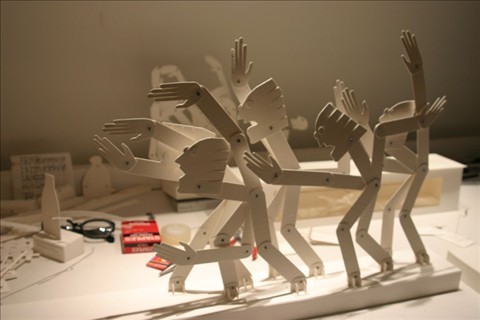 At long last, then, we were able to visit Danny at his current residence. He's living in a basement room -- not even a full apartment. He shares the bathroom and kitchen with several other residents. Into this tiny room Danny has squeezed a small library, a PC, a bed, a workbench, and numerous shelves filled with wonders -- more than most people can manage in an entire house.
At long last, then, we were able to visit Danny at his current residence. He's living in a basement room -- not even a full apartment. He shares the bathroom and kitchen with several other residents. Into this tiny room Danny has squeezed a small library, a PC, a bed, a workbench, and numerous shelves filled with wonders -- more than most people can manage in an entire house.
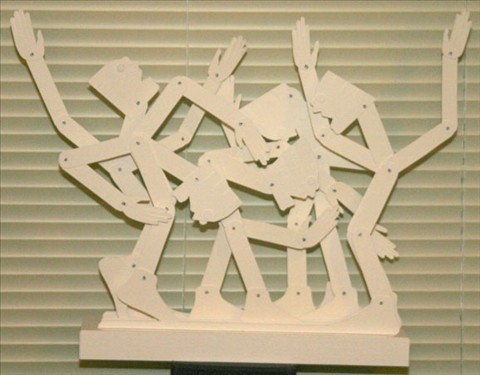 Entering his room I immediately thought of Alexander Calder. Calder made a lot of neat little toys in addition to his mobiles and stabiles, and one of the sad things about his body of work is seeing it encased in glass where it can never be touched or played with. Being in Danny's room is like seeing Calder's work -- only you're allowed to play with it. In fact Danny encourages playing with it, and will play with it himself if you give him half a chance.
Entering his room I immediately thought of Alexander Calder. Calder made a lot of neat little toys in addition to his mobiles and stabiles, and one of the sad things about his body of work is seeing it encased in glass where it can never be touched or played with. Being in Danny's room is like seeing Calder's work -- only you're allowed to play with it. In fact Danny encourages playing with it, and will play with it himself if you give him half a chance.
Dan is aware of the Calder connection; he says he remembers when he was starting to make objects he opened a book on Calder, looked at the first page, and immediately closed it. He knew he wouldn't be able to go on if he read more. He spent a few years studiously avoiding learning anything about Calder, although now, of course, he's familiar with his work. Dan's earlier work -- which I didn't get photos of -- is much more Calderish, all wires and little mechanisms for moving. As he's moved into paper, though, he's moved away from Calder's drawing with wire.
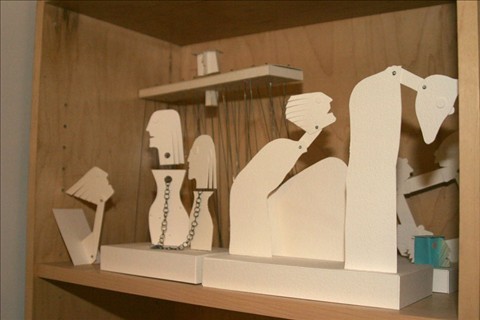 Danny's larger works -- the outdoor ones -- are made of metal, bent and cut and glued to the wall or stood up. His smaller works are made of 300-pound watercolor paper and wire. He used to color the paper more; these days the most he'll do is paint a small piece black, or put in a dot here and there. Each of the things he makes is interactive in some way, whether it changes as you move around it or you move it around yourself. Recently he's become quite interested in shadows and how they change as the light moves.
Danny's larger works -- the outdoor ones -- are made of metal, bent and cut and glued to the wall or stood up. His smaller works are made of 300-pound watercolor paper and wire. He used to color the paper more; these days the most he'll do is paint a small piece black, or put in a dot here and there. Each of the things he makes is interactive in some way, whether it changes as you move around it or you move it around yourself. Recently he's become quite interested in shadows and how they change as the light moves.
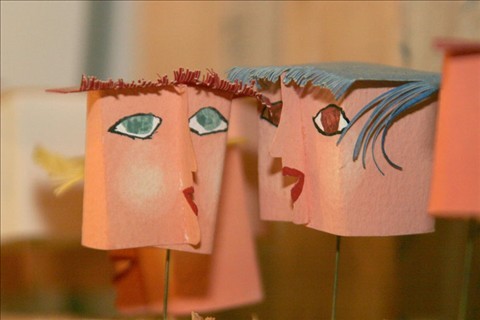 Here's an example of interactivity: This piece is called, I think, Party People. It's a number of heads made of painted, folded paper, mounted loosely on little pieces of wire, which are then mounted on a block of wood. If you shake the block, the heads all whisper together, like that sound you hear when you first walk into a party.
Here's an example of interactivity: This piece is called, I think, Party People. It's a number of heads made of painted, folded paper, mounted loosely on little pieces of wire, which are then mounted on a block of wood. If you shake the block, the heads all whisper together, like that sound you hear when you first walk into a party.
Another piece involves two paper pigeons. You can turn a wire underneath the folded paper platform and watch as one amorous pigeon chases the other around. Or in another one (on the left in the next photo), Ben Franklin orates while waving his hands around.
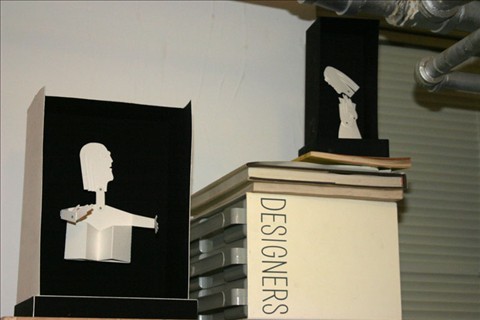
His pieces are whimsical without being too cute; ultimately, under most of them, there's a sharp edge, something that makes you feel it's not all fun and games. His figures, for example, often seem to be tormented, yelling or screaming. Some wear chains or have heavy wheels hung around their necks. Sometimes they seem to be twisted in agony or fighting against the wind or reaching in supplication. The figures are surprisingly human despite being very minimal.
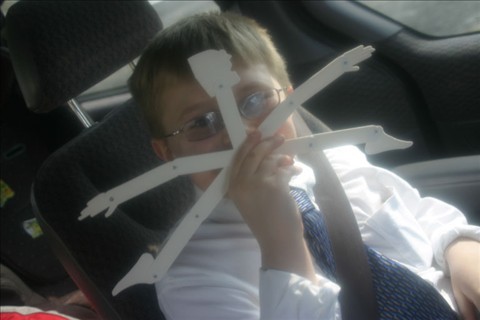 As a "door prize" Danny gave Stephanie and me one figure each and I immediately had mine curl up into a ball. It perfectly radiated exactly how I felt when I was depressed. I brought it home and gave it to my son to play with and he stretched it out into an expansive running pose. My daughter got ahold of it later and put it through classical ballet positions while giving it orders: "Pay attention to your position!"
As a "door prize" Danny gave Stephanie and me one figure each and I immediately had mine curl up into a ball. It perfectly radiated exactly how I felt when I was depressed. I brought it home and gave it to my son to play with and he stretched it out into an expansive running pose. My daughter got ahold of it later and put it through classical ballet positions while giving it orders: "Pay attention to your position!"
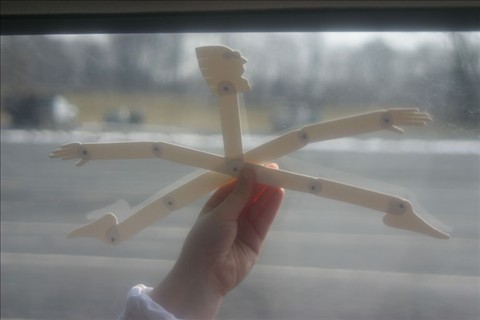 Danny was, of course, delighted to hear my kids were playing with his art. Many artists will take a stand against the preciousness of art objects by making something ugly or rotten, or something that will disintegrate gracelessly. Danny makes the same point but with style and beauty.
Danny was, of course, delighted to hear my kids were playing with his art. Many artists will take a stand against the preciousness of art objects by making something ugly or rotten, or something that will disintegrate gracelessly. Danny makes the same point but with style and beauty.
 It really is impossible to convey the sense of exhilaration and possibility I get from knowing Danny. The three of us had planned to take a drive and visit some of his outdoor pieces but ended up talking so much we barely made it outside for a short walk to my car to get some of my paintings I'd brought. I think I wore Stephanie and Danny out; they were nearly asleep on the bed (I was sitting in the only chair) by the time we called it a night. The feeling that I'm seeing something big and wonderful happen is one I've felt so rarely; it makes me feel 17 years old again, back when the world was wide open and anything could happen and the future was boundless.
It really is impossible to convey the sense of exhilaration and possibility I get from knowing Danny. The three of us had planned to take a drive and visit some of his outdoor pieces but ended up talking so much we barely made it outside for a short walk to my car to get some of my paintings I'd brought. I think I wore Stephanie and Danny out; they were nearly asleep on the bed (I was sitting in the only chair) by the time we called it a night. The feeling that I'm seeing something big and wonderful happen is one I've felt so rarely; it makes me feel 17 years old again, back when the world was wide open and anything could happen and the future was boundless.
